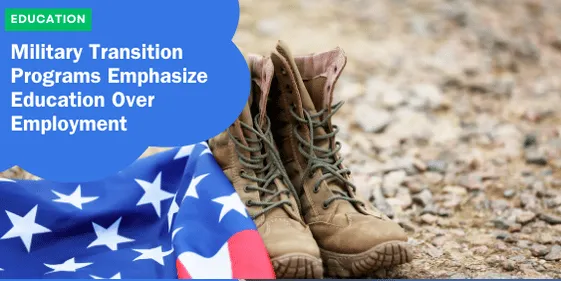Military Transition Programs Emphasize Education Over Employment

Nearly all military-to-civilian transition programs are primarily focused on upskilling, retraining, or providing educational opportunities rather than directly aiding service members and veterans in finding employment, according to a recent study.
This research, conducted by the Rand Corporation, scrutinizes the annual expenditure of nearly $13 billion on these transition programs, examining how the funds are allocated, potential overlaps between programs, and their effectiveness.
Allocation of Transition Program Funds
The study reveals that the majority of the federal budget dedicated to military-to-civilian transition programs is channeled towards educational assistance, leaving minimal resources for programs that directly assist with job placement beyond the Department of Defense’s Transition Assistance Program (TAP).
This emphasis on education over employment assistance coincides with the ongoing increase in college tuition fees and a rising trend of Americans choosing not to pursue higher education.
Notably, undergraduate enrollment in 2021 was 15% lower than in 2010.
As per the report, “While it’s reasonable to allocate substantial portions of the transition budget to education given the rising costs of college, many veterans prefer or need to enter the workforce right away.”
For this study, researchers analyzed 45 transition programs overseen by 11 federal agencies, ranging from major budgetary programs like the Post-9/11 GI Bill and the DoD’s Tuition Assistance Program, to smaller initiatives such as the Montgomery GI Bill and the DoD’s TAP.
Fragmented Oversight and Redundancies
Due to the involvement of various agencies, oversight of these 45 federally-funded transition programs is described as “weak and fragmented.”
This fragmented oversight has led to numerous redundancies in programs and services, according to the researchers.
For instance, the Post-9/11 GI Bill, one of the largest transition programs, provides limited information on its effectiveness, specifically on how many service members and veterans use it and how many of them graduate from the program.
Effectiveness of Transition Programs
Another critical aspect examined by the researchers is the effectiveness of these federally-funded employment transition programs.
The study finds insufficient evidence to support the effectiveness of these programs.
In fact, it reveals that participants in the DoD’s TAP experience lower wage growth compared to non-participants.
Specifically, TAP participants earn $1,974 less than non-participants six months post-separation, $1,362 less at 24 months post-separation, and $1,238 less at 36 months post-separation.
Furthermore, student veterans participating in the Post-9/11 GI Bill program also experience lower earnings after leaving the service.
In some cases, this has even resulted in negative returns on investment in education.
Data and Reporting Gaps
The study highlights significant gaps in data and reporting, especially for smaller transition programs.
Many of these programs lack adequate reported data to assess their effectiveness.
The report emphasizes, “The most significant gap identified is the lack of program evaluations. While some programs have undergone assessments mandated by Congress, much of the information on program effectiveness stems from small-scale or otherwise limited studies.”
Recommendations for Improvement
Consistent and standardized reporting would not only enhance transparency but also help policymakers and stakeholders make informed decisions about funding allocations and program improvements.
Additionally, it could lead to better coordination among the various federal agencies involved in these programs, reducing redundancies and improving overall effectiveness.
The Future of Military Transition Programs
As the needs of service members and veterans evolve, it is crucial for military-to-civilian transition programs to adapt and provide comprehensive support beyond educational assistance.
While education is undeniably important, immediate employment opportunities and job readiness are equally vital for veterans re-entering civilian life.
A balanced approach that addresses both educational and employment needs would ensure that veterans receive holistic support, improving their transition outcomes and long-term well-being.
Furthermore, increased oversight and accountability are essential for ensuring that federal funds are used effectively and that transition programs deliver tangible benefits.
By implementing the recommendations for standardized reporting and enhanced oversight, policymakers can better identify areas of improvement, allocate resources more efficiently, and ultimately provide more effective support for service members and veterans.
Conclusion: A Call for Comprehensive Support
The focus of military transition programs on education over employment highlights a significant gap in the support provided to service members and veterans.
While educational assistance plays a crucial role in helping veterans acquire new skills and qualifications, the immediate need for employment opportunities should not be overlooked.
Addressing the challenges of fragmented oversight, data gaps, and program redundancies requires concerted efforts from policymakers, federal agencies, and stakeholders.
By prioritizing both educational and employment support, streamlining oversight, and ensuring consistent and transparent reporting, the effectiveness of military-to-civilian transition programs can be significantly enhanced.
In summary, a comprehensive and balanced approach is essential to support the diverse needs of service members and veterans as they transition to civilian life.
Through thoughtful and coordinated efforts, it is possible to provide veterans with the resources and opportunities they need to thrive, ultimately recognizing their sacrifices and contributions to the nation.






